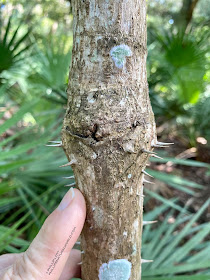 |
| Devil's Walkingstick (Aralia spinosa) |
At the southernmost extent of its range I found a colony of Devil's Walking Stick (Aralia spinosa) thriving between I-4 and 17-92 on the River-2-Sea-Loop Trail in Debary. Pretty amazing to find anything thriving in here as the trial is being squeezed by development.
🌿Follow Phillip🌱
 |
| Devil's Walkingstick bloom (Aralia spinosa) |
The 25-foot tall plants are in full bloom this August. This species is also sometimes referred to as Prickly Ash, Angelica-tree, Prickly Elder, and Hercules' Club.
 |
| Devil's Walkingstick berries (Aralia spinosa) |
Aralia spinosa is an aromatic deciduous shrub or small tree growing 6-26 feet tall.
 |
| Devil's Walkingstick thorny ramet (Aralia spinosa) |
One look at this plant will show you how it earned its common name of devil's walking stick. Vicious spines cover the stem and other areas of the plant, warning all to stay away.
 |
| Devil's Walkingstick thorny stem (Aralia spinosa) |
There are a number of juvenile members of this colony spread around the main A. spinosa trees. Its not clear if these are rhizomatous or separate individual plants, however, this species perennates by rhizomes producing ramets. Ramets are distinct plants but are genetically identical to their progenitor. So in this colony there is likely a single parent plant.
 |
| Devil's Walkingstick rhizomatous colony (Aralia spinosa) |
The stems tend to remain unbranched until the first terminal inflorescences (below) are produced at an average age of 3.5 years.
 |
| Devil's Walkingstick (Aralia spinosa) prefers sunny opening in the canopy |
First year ramets produce abundant prickles on the stems and leaves of first-year ramets.
 |
| Devil's Walkingstick (Aralia spinosa) |
Devil's Walking Stick prefers rich moist soils and is often found at the edges of streams, in thickets and shrub bays. Here, the plant thrives in the flood plain of the St. Johns River which is muck-rich but rarely completely flooded.
 |
| Devil's Walkingstick ramet (Aralia spinosa) |
Devil's Walkingstick is shade intolerant but here it seems to thrive in partial sun under a canopy of live oak.
 |
| Devil's Walkingstick (Aralia spinosa) |
Insects harvest pollen and nectar from the flowers of devil's walkingstick. The fruits are used as food by many birds and other frugivores, including black bear.
The bark, roots, and berries of devil's walkingstick have been used for medicinal purposes, both by Native Americans and European settlers.
 |
| Devil's Walkingstick (Aralia spinosa) |
Also found along this section of trail are several stands of Late Boneset.
Late Boneset
 |
| Late Boneset (Eupatorium serotinum) |
Late Boneset (Eupatorium serotinum) is an herbaceous perennial plant that grows 3-6 feet tall in Central Florida. It is largely unbranched below, but forms occasional side stems toward the apex. The stems have indistinct lines of white hairs, and are generally pubescent (meaning covered by a layer of fine hair).
 |
| Late Boneset (Eupatorium serotinum) |
The flat-topped inflorescence consists of numerous heads of white disk florets; there are no ray florets. Each flowerhead has about 12 disk florets. Each disk floret is about ¼" long, narrow and tubular, with 5 small triangular lobes at the top. There is also a long divided style that is white, which protrudes conspicuously from each floret.
 |
| Late Boneset (Eupatorium serotinum) |
The blooming period occurs in late summer-early fall and lasts about a month. There was only a mild floral scent on these individuals. This plant (like the devil's walkingstick) forms small colonies by means of rhizomes.
Depending on where you are across this plant's range it is referred to also as Lateflowering thoroughwort, Fall boneset, Late flowering boneset, and Late eupatorium.
 |
| Late Boneset (Eupatorium serotinum) |
The flowers of Late Boneset are popular with many kinds of insects, including bees, wasps, flies, small to medium-sized butterflies, skippers, moths, and beetles. Most of these insects seek nectar, although bees may collect pollen. Ailanthus Webworm Moths have been photographed on this species in other parts of its range.
 |
| Late Boneset (Eupatorium serotinum) |
On this very hot August afternoon the trail is devoid of insects, larger animals, and people.
Both of these colonies of native plants can be best seen by accessing the trail from the Lake Monroe Trailhead which is on the southeast side of the Lake Monroe Park on 17-92 in Debary.
 |
| River 2 Sea Loop Trail near Lake Monroe Trailhead Pat Northey Section |
If you look at map of this trail you see that it is being squeezed on both sides by large highways and now a massive apartment complex.
No comments:
Post a Comment